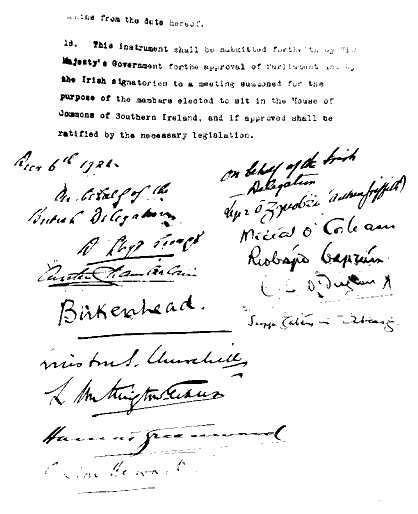
Signature page of the Anglo-Irish Treaty
|
Signature page of the Anglo-Irish Treaty |
The Anglo-Irish Treaty was a treaty between the
Government of the United Kingdom and representatives of the (extra-judicial)
Irish Republic which concluded the Irish War of Independence (Anglo-Irish
War: January 1919-1921 July). It established an
Irish dominion within the British Empire known as the Irish Free State and
provided an option for the previously existing Northern Ireland, created by the
1920 Government of Ireland Act, to opt out of the Irish Free State, which it
right away did.
The treaty was signed in London by representatives of the British government and
envoys
plenipotentiary of the Irish Republic on
December 6, 1921. Three-fold ratification of the treaty by Dáil Éireann
(the
House of Commons of Southern Ireland) and the British Parliament was required.
The Irish side was split on the Treaty, and it was only narrowly ratified in the
Dáil. Though duly enacted, the split produced the Irish Civil War (1922-23)
which was ultimately won by the pro-treaty side.
The Irish Free State created by the Treaty came into force on 6 December 1922 by
royal proclamation, after its constitution was enacted by the Third Dáil and the
British parliament.
Among its main clauses were that:
§ British forces would withdraw from most of Ireland.
§ Most of Ireland was to become a self-governing dominion of the British Empire, like Canada, Newfoundland, Australia, New Zealand and The Union of South Africa.
§ As with the other dominions, the head of state of the Irish Free State (Saorstát Éireann) would be the British monarch, who would be represented by a Governor General
§ Members of the new Free State's parliament would be required to take an Oath of Allegiance to the Free State. A secondary part of the Oath was to "be faithful to His Majesty King George V., his heirs and successors by law, in virtue of the common citizenship" as part of the Treaty settlement.
§ Northern Ireland (which had been created earlier by the Government of Ireland Act) was to have the option of withdrawing from the Irish Free State within one month of the Treaty coming into effect.
§ If Northern Ireland chose to withdraw, a Boundary Commission would be constituted to draw the boundary between the Irish Free State and Northern Ireland.
§ Britain, for its own security, would continue to control a limited number of ports, known as the Treaty Ports, for the Royal Navy.
§ The Irish Free State would assume responsibility for its part of the Imperial debt.
§
The Treaty would have superior status in Irish
law: in the event of a conflict between it and the new 1922 Constitution of the
Irish Free State, it would take precedence.
|
plenipotentiary |
teljhatalmú |
credits:
1. The text was extracted from Wikipedia The Free Encyclopedia under GNU Free Documentation Licence.